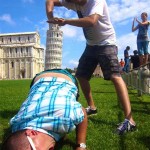
Mera Bharat Mahaan
We Indians are a motley group. And more so when we travel. We are as different from one another as a kangaroo is different from a peepul tree. You might be the kind who is fascinated by the idea of spending hours trying to decipher Arabic passages inscribed on the Taj Mahal, but a fun-loving north Indian might be inclined to hit you if you propose the idea to him. Truth is, we all have our own ideas and preferences when it comes to travel.
And though we are all unique and cool and blah, these preferences are majorly region and culture specific. We can’t help it. Like they say in a pseudo-profound tone, you can take the man out of his land but you can’t take the land out of the man.
Pardon me for the stereotyping. It’s all in good fun. Of course, we all know stereotypes are just a way of simplifying the world. Yeah yeah, you are not the boring conventional type.
The Boisterous Punjabis
They are loud, they are boisterous, they are fun. And when travelling, they are a thousand times more Punjabi-fied. If you are Punjabi, you got to be ‘cool’.
When on a trip, they will visit the best bar, the best restaurant, even the second, third and thirtieth best. A monument can be given a miss, but not a cool restaurant or a bar. Don’t dare to recommend a boring sightseeing place to a Punjabi. He might strangle you when he returns.
They don’t take pictures of monuments—that’s something that nerds, historians, or ugly people do—they get themselves clicked instead.
They are not cautious travellers. They might run out of money for food. No worries, there is liquor. They might get sloshed. No worries; there’s lemon. Actually, they never get sloshed. Punjabis have an unlimited capacity for alcohol. If you can’t hold your drink, you aren’t Punjabi. Sorry, you were adopted.
The Gujju brigade
They are frugal, they are smart, they are business people. They won’t get travellers’ diarrhoea. They won’t get broke. They won’t starve. They are well-prepared.
Khakra, phafda, jalebi. These are not just the names of foods. These are what the Gujjus breathe, sleep, drink, and then eat. They are so in love with their food that they carry it with themselves wherever they go. If a lipstick is what you’d find in a woman’s handbag, a packet of khakra is what you’d see in a Gujarati’s bag. Kidding. That is not always true. There are some women who don’t apply lipstick.
Ooh and they are rich. They will check in the most filthily expensive hotels. The ones with the hottest night clubs and finest dine-outs. And then they will appear in the heaviest of embroidered sarees, jewellery, formal suits and oiled hair.
The Scholarly South Indians
They are well-read. They are geeky.
Picture this:
South-Indian tourist gets out of car/bus. He looks all around in awe. You wonder what’s so fascinating since all you can see is a deserted road, a few buildings here and there, and two trees. He starts to click pictures. A la the Japanese who have DSLR cameras hanging from their necks all the time.
“Aiyyoo, saar, will you stand out of the way? I have to click that tree with only the monkey on it. Monkeys too are ancient, you know.”
“Ah look! That rock is oh-so-artistic!”
They know all about that beautifully-carved pillar. It was built by the Chola kings. In the 10th century. On the third night of the fifth month. At 3.43 p.m.
They go to a dance bar. They see all Punjabis dancing. Puhleez! You call that dance? Let us show you how it’s done.
They don’t go to hill stations. They don’t go to adventure parks. They go to see marvels of the world. The kind that invite gaping reactions from people when you tell them you have been there.
The Firang
This is how anyone with light-coloured skin and hair, and hailing from anywhere beyond Pakistan is referred to as. The typical firang backpacker in India is over 6-feet tall. Skin flushed red from the sun. Is often spotted in tattered and extremely thin clothing.If you are cheap enough to look closely, you might also spot some holes here and there. The footwear is usually some sasta chappal from Paharganj.
He has been fleeced numerous times on the streets. Almost always, stared at. But he is still all starry-eyed about the country. He will still visit the same streets and still click the rikshawallas with the same enthusiasm.
At heritage sites and monuments, you are likely to spot more firangs than Indians. If you want to get his attention, try wearing your ethnicity up your sleeve. Once in Udaipur, a white lady was so enamoured by a Kashmiri dupatta worn by an Indian lady that she nearly pounced on the old lady in a bid to touch the fabric of the dupatta.
It’s funny to see the rikshawallas, chaiwallas, and chowkidars smile in indulgent condescension at this breed. It is colonialism in reverse.
The NRI (the not-so-real Indian)
They look like Indians, but they have accents that match neither the locals’ nor the firang’s. They are overawed by bhartiya sanskriti but not as overwhelmed as the firang. They are nostalgic about it. So, when they visit a historical site, they will pass discreet (yet loud enough for passers-by to hear) comments about the place’s oh-mera-bharat-mahaan history, but they will wince disapprovingly at the noisy middle-class Indian family sitting beside them on the tram.
The Binging Bengali

Stop! You are on a holiday!
It doesn’t matter whether it’s Kashmir or Kanyakumari, the quintessential Bengali’s world revolves around two things – politics and food. No, three; add literature to the list. So when he is not busy dissecting political theories in addas, or quoting Tagore for the eighteenth time in a single day, he is busy eating.
Whether it is fish curry or even Parle-G biscuits, the Bengali takes his food very seriously. And if it is not a place of particular literary or artsy interest, food is all there is to the trip. The Bengali doesn’t just love his food; he worships it.
Even if he goes to Goa, he is likely to wear his old khadi kurta and carry the kaatha-stitched bag he bought from Kolkata. He might not have worn it in Kolkata though. And it is quite likely that he might sit down to cook his own aloo posto there.
























TravelerSuggest
RT @ThakurRajesh: We are Different, We Behave Different http://t.co/VnHRw8Eu4g #featured #humour #people #tourism #travellinginindia
The description of bongs is bang on but a funnier picture just like the one for the firang traveler would have made it even more funny lovely read n keep up the good work
lovely read n keep up the good work 
Pranika, thank you! I hope the world keeps on its eccentricities intact, mine included. And yes I agree about the picture. I guess no bong cartoonist was allowed to sketch a funnier picture.
harkirat_82
RT @WeAreHolidays: We are different,we behave different; yet we are very much #Indian http://t.co/V3PiJeTmFM #indiatravel
Great article. Keep it up. Nice way to bring out some real hidden truths
hahaha so true… this reminds me with few incidents with each one of them…bengalis, gujaratis… and i must say you have succeeded in getting the key points that i witnessed